This page defines various types of waste and other tires and discusses/shows the difference between “used” and “waste” tires. This information is important to understand in determining the number of tires at a site. For inspection purposes, only waste tires are counted toward total number of tires allowed.
Waste Tire Definitions
30 Public Resources Code (PRC) § 42807 defines a “waste tire” as a tire that is no longer mounted on a vehicle and is no longer suitable for use as a vehicle tire due to wear, damage, or deviation from the manufacturer’s original specifications. A waste tire includes a repairable tire, scrap tire, and altered waste tire, but does not include a tire-derived product, crumb rubber, or a used tire that is organized for inspection and resale by size in a rack or a stack in accordance with Section 42806.5.
Altered Waste Tire (30 PRC 42801.5)
(a) “Altered waste tire” means a waste tire that has been baled, shredded, chopped, or split apart. “Altered waste tire” does not mean crumb rubber.
(b) “Alteration” or “altering,” with reference to a waste tire,
means an action that produces an altered waste tire.
Types of altered waste tires:
- Sidewalls or Treads. Tires where the sidewalls and treads have been cut away from each other. (See photo below.)
- Primary Shreds. Tires that have been run through a shredder one time.
- Shreds 2 inch or smaller. Tires that have been run through a shredder more than once to create pieces two inches or smaller.
Repairable Waste Tire (30 PRC 42805.5)
“Repairable tire” means a worn, damaged, or defective tire that is retreadable, recappable, or regrooveable, or that can be otherwise repaired to return the tire to its use as a vehicle tire, and that meets the applicable requirements of the Vehicle Code and Title 13 of the California Code of Regulations.
Scrap Tire (30 PRC 42805.6)
“Scrap tire” means a worn, damaged, or defective tire that is not a repairable tire.
Therefore, a waste tire is a tire that is not brand new, nor is it mounted on a vehicle, and it is not stored in a manner for display and sale that allows for inspection of the tread. A waste tire is not intended for use on a vehicle again. A tire intended for use on a vehicle again may still be
Not Defined as a Waste Tire
Used Tire
30 PRC § 42806.5 defines “used tire” as a tire that meets all of the following:
- The tire is no longer mounted on a vehicle but is still suitable for use as a vehicle tire.
- The tire meets applicable requirements of the Vehicle Code and Title 13 of the California Code of Regulations.
- Tire Storage:
(a) The used tire is stored by size in a rack or a stack, but not in a pile in a manner approved by the local fire marshal and vector control authorities and in accordance with state minimum standards.
(b) A used tire stored pursuant to this section shall be stored in a manner to allow the inspection of each individual tire.
Crumb Rubber (30 PRC 42801.7)
“Crumb rubber” means rubber granules derived from a waste tire that are less than or equal to one-quarter inch or six millimeters in size.
Tire Derived Product (30 PRC 42805.7)
“Tire derived product” means material that meets both of the following requirements:
(a) Is derived from a process using whole tires as a feedstock. A process using whole tires includes, but is not limited to, shredding, crumbing, or chipping.
(b) Has been sold and removed from the processing facility.
Waste vs. Used Tires
When inspecting a site, field staff will need to know the difference between a waste tire and a used tire. Tires that meet the definition of a used tire are not added to the total tire count of waste tires at a site. However, if a hauler is stopped/inspected while hauling tires, waste and used tires are added to the total count of waste tires hauled.
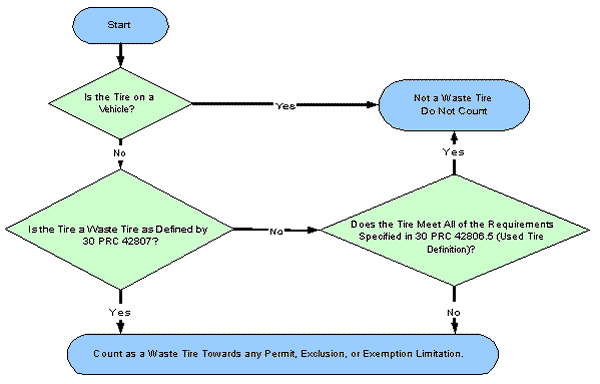
The following photos illustrate the difference between what is counted as a used tire and what is counted as a waste tire when it comes to storage of tires, especially at used tire dealer locations.
Tires in this photo appear to meet the requirements of 30 PRC § 42806.5 and are counted as used tires, not waste tires.

Most of the tires in this photo that are not in the metal racks are counted as waste tires, because they are not stacked for display in a manner that allows each tire to be inspected individually like in the previous photo.
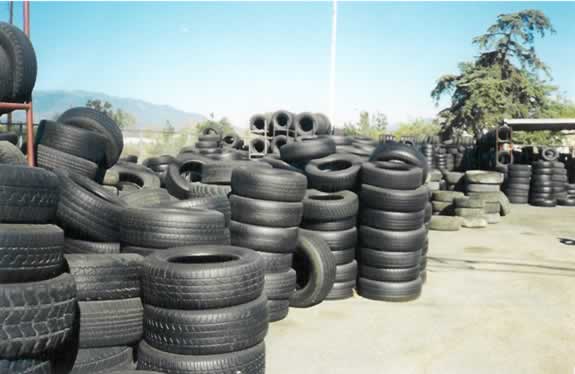
The tires in the “barrel stacked” columns nearest the front in this picture are counted as used tires, while the other tires in barrel stacked columns that are blocked and surrounded by other stacks of tires are counted as waste tires because they cannot be inspected individually.

Tires that a dealer indicates are to be scrapped and taken to the landfill or other end processing facilities are also counted as waste tires. Old tires that are stored in unpermitted/unauthorized sites and facilities are also counted as waste tires. The picture to the right is of an unpermitted waste tire site that had implied access when the picture was taken. Tires such as the ones in this picture are counted as waste tires since they are piled together and are not part of a used tire dealer’s business.
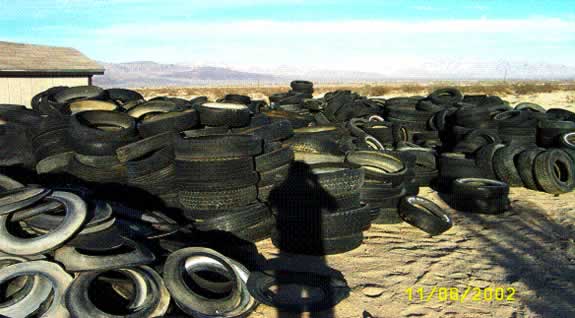
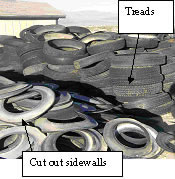 The sidewall cutouts in the picture at left are indicative of some kind of processing of waste tires for a use other than for reuse on a vehicle.
The sidewall cutouts in the picture at left are indicative of some kind of processing of waste tires for a use other than for reuse on a vehicle.
The photos below illustrate the different ways that tires might be stored. Tires that are blocked and surrounded by other stacks of tires are counted as waste tires because they cannot be inspected individually.
Loose Stacking
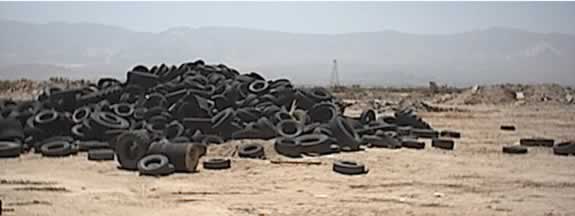
Laced Stacking
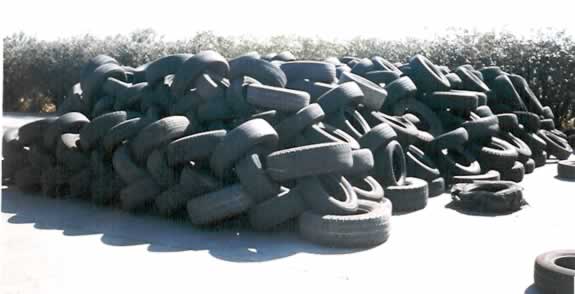
Barrel Stacking Horizontally
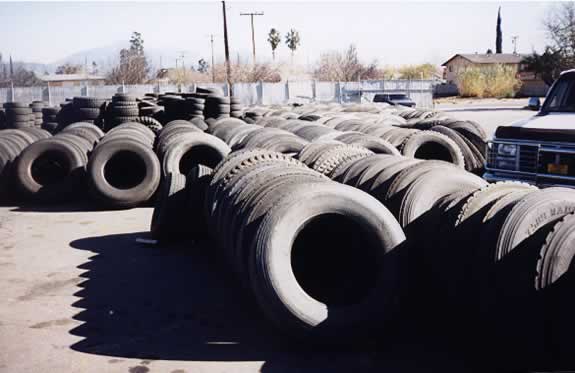
Barrel Stacking Vertically

For more information contact: Tire Enforcement, WasteTires@calrecycle.ca.gov

